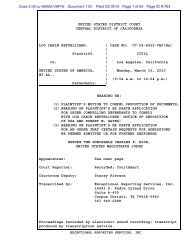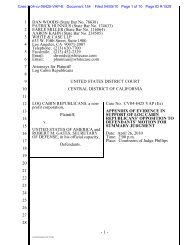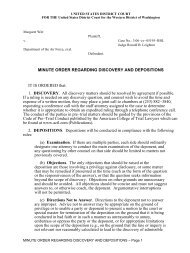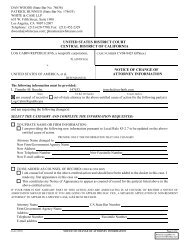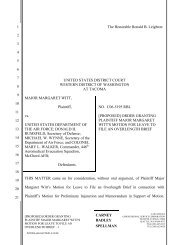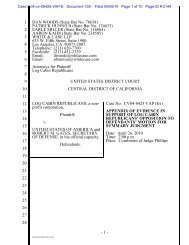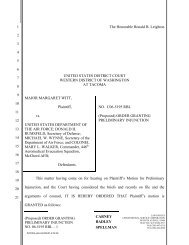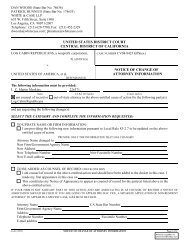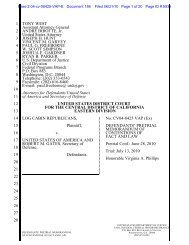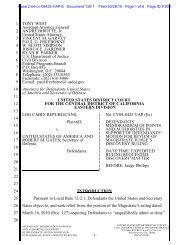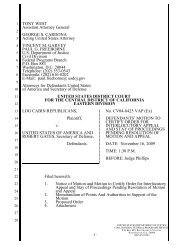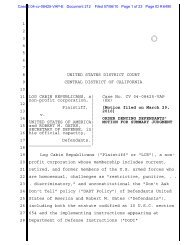Government Opposition to File Ex Parte Application - The DADT ...
Government Opposition to File Ex Parte Application - The DADT ...
Government Opposition to File Ex Parte Application - The DADT ...
Create successful ePaper yourself
Turn your PDF publications into a flip-book with our unique Google optimized e-Paper software.
Case 2:04-cv-08425-VAP-E Document 119-4 <strong>File</strong>d 03/08/10 Page 1 of 5 Page ID #:639<br />
<strong>Ex</strong>hibit C
Case 2:04-cv-08425-VAP-E Document 119-4 <strong>File</strong>d 03/08/10 Page 2 of 5 Page ID #:640<br />
U.S. Department of Justice<br />
Civil Division, Federal Programs Branch<br />
By First-Class Mail By Special Delivery<br />
P.O. Box 883 20 Massachusetts Ave., NW<br />
Washing<strong>to</strong>n, D.C. 20044 Washing<strong>to</strong>n, D.C. 20001<br />
Ryan B. Parker Tel: (202) 514-4336<br />
Trial At<strong>to</strong>rney Fax: (202) 616-8470<br />
Email: ryan.parker@usdoj.gov<br />
By Electronic Mail and First-Class Mail<br />
Patrick Hunnius<br />
White & Case, LLP<br />
633 West Fifth Street, Suite 1900<br />
Los Angeles, CA 90071-2007<br />
March 5, 2010<br />
Re: Log Cabin Republicans v. U.S. et al.: Plaintiff’s Proposed <strong>Ex</strong> <strong>Parte</strong> <strong>Application</strong>s<br />
Patrick,<br />
I write <strong>to</strong> express the <strong>Government</strong>’s opposition <strong>to</strong> Plaintiff’s proposal <strong>to</strong> file ex parte<br />
applications seeking orders compelling discovery. Plaintiff’s proposed ex parte applications<br />
contradict Plaintiff’s counsel’s representations <strong>to</strong> Defense counsel and the Court, violate Judge<br />
Phillips’s Standing Order, and lack legal support. At bot<strong>to</strong>m, they appear <strong>to</strong> be attempts <strong>to</strong> circumvent<br />
the March 15 discovery deadline. If Plaintiff nonetheless decides <strong>to</strong> file its proposed applications, the<br />
<strong>Government</strong> respectfully that this letter, and the accompanying attachments, be submitted <strong>to</strong> the Court<br />
with Plaintiff’s filing.<br />
I. Plaintiff Failed <strong>to</strong> Provide a Timely Joint Stipulation Regarding the 30(b)(6)<br />
Depostion<br />
<strong>The</strong> process for resolving any dispute with respect <strong>to</strong> the 30(b)(6) deposition had been worked<br />
out by the parties. As part of that process, on Wednesday, March 3, 2010, Plaintiff’s counsel emailed<br />
Defense counsel its portion of a “JOINT STIPULATION IN SUPPORT OF: (1) PLAINTIFF’S<br />
MOTION TO COMPEL DEPOSITION OF DEFENDANTS UNITED STATES OF AMERICA AND<br />
ROBERT M. GATES PURSUANT TO F.R.C.P. 30(b)(6); AND (2) DEFENDANTS’ MOTION FOR<br />
A PROTECTIVE ORDER.” See Attachment 1 - Plaintiff’s Email Sending Joint Stipulation;<br />
Attachment 2 - Plaintiff’s Portion of the Joint Stipulation. In the introduction <strong>to</strong> Plaintiff’s Portion of<br />
the Joint Stipulation (“Plaintiff’s Joint Stipulation”), Plaintiff set forth the background for the cross<br />
motions indicating that a process for resolving the issues already was in place:<br />
“On December 21, 2009, Plaintiff served on Defendants a 30(b)(6) Notice<br />
of Deposition (“Notice”) <strong>to</strong> be taken on January 25, 2010 at the offices of<br />
Plaintiff’s counsel in Washing<strong>to</strong>n, D.C. On January 29, 2010, Defendants
Case 2:04-cv-08425-VAP-E Document 119-4 <strong>File</strong>d 03/08/10 Page 3 of 5 Page ID #:641<br />
objected <strong>to</strong> the Notice, via a letter <strong>to</strong> Plaintiff’s counsel. <strong>The</strong> parties<br />
met-and-conferred telephonically regarding the Notice on February 9, 2010<br />
but were unable <strong>to</strong> resolve their differences. At the conclusion of the<br />
conference, both parties maintained their respective contentions that they<br />
have grounds for a motion regarding the Notice (for Plaintiff, a motion <strong>to</strong><br />
compel; for Defendants, a motion for a protective order) and agreed <strong>to</strong> brief<br />
these cross-motions through one Local Rule 37 ‘joint stipulation.’”<br />
Attachment 2, pg. 1-2. <strong>The</strong>re was indeed a meet and confer, and the agreement <strong>to</strong> brief the issue<br />
through cross motions was set forth more fully in a letter Plaintiff’s counsel sent <strong>to</strong> Defense counsel<br />
on February 11, two days after the meet and confer. See Attachment 3- Plaintiff’s Counsel’s February<br />
11 Letter, pg 6. <strong>The</strong> schedule called for Plaintiff <strong>to</strong> send Defendants Plaintiff’s portion of the required<br />
Joint Stipulation on February 22 and set an expedited briefing schedule based on the rapidly<br />
approaching March 15 discovery deadline. See Attachment 3, pg. 6. At the Status Conference, held on<br />
February 18, Plaintiff’s counsel confirmed in open court that the 30(b)(6) issue would be briefed<br />
through motion practice: Plaintiff’s Motion <strong>to</strong> Compel and Defendants’ Motion for a Protective Order.<br />
When Plaintiff’s counsel failed <strong>to</strong> send Defendants Plaintiff’s portion of the Joint Stipulation<br />
on February 22, as previously agreed. Defense counsel assumed that Plaintiff’s counsel had decided<br />
<strong>to</strong> seek the requested information though other forms of discovery, as Plaintiff had asked for the same<br />
information in interroga<strong>to</strong>ries, document requests, and requests for admission.<br />
On the evening of March 3, much after the agreed upon date, Plaintiff’s counsel emailed<br />
Defense counsel Plaintiff’s Joint Stipulation. See Attachment 2. <strong>The</strong> belated stipulation proposed a<br />
new briefing schedule, asking Defendants <strong>to</strong> provide their portion of the Joint Stipulation by March<br />
11. Plaintiff’s stipulation contained Plaintiff’s legal arguments and nowhere alleged, nor could it in<br />
good faith, that Defense counsel had failed <strong>to</strong> cooperate in the parties’ agreement <strong>to</strong> brief the issue<br />
through cross motions. Rather, the stipulation indicated just the opposite: the parties had met-andconferred<br />
and Plaintiff was belatedly initiating the process that had been agreed upon.<br />
Just one day later, on March 4, Plaintiff’s counsel sent Defense counsel an email explaining<br />
that Plaintiff intended <strong>to</strong> file an ex parte application seeking an order compelling the <strong>Government</strong> <strong>to</strong><br />
designate a witness pursuant <strong>to</strong> the 30(b)(6) notice. See Attachment 4 - Plaintiff’s counsel’s Email of<br />
March 4. In the email, Plaintiff’s Counsel explained why he felt ex parte relief was necessary:<br />
“<strong>Ex</strong> parte relief is necessary in light of: the rapidly approaching<br />
discovery cu<strong>to</strong>ff; the government's failure <strong>to</strong> respond <strong>to</strong> Plaintiff's prior<br />
reasonable proposal <strong>to</strong> brief and hear these issues prior <strong>to</strong> the discovery<br />
cu<strong>to</strong>ff; and the government's intransigent refusal <strong>to</strong> designate a witness<br />
on any <strong>to</strong>pic specified in the Notice.”<br />
Attachment 4 (emphasis added).<br />
- 2 -
Case 2:04-cv-08425-VAP-E Document 119-4 <strong>File</strong>d 03/08/10 Page 4 of 5 Page ID #:642<br />
Plaintiff’s counsel’s March 4 email changes course and attempts <strong>to</strong> shift the blame <strong>to</strong><br />
Defendants for Plaintiff’s failure <strong>to</strong> follow the parties’ expedited briefing schedule. Plaintiff’s<br />
counsel’s new position appears <strong>to</strong> be motivated by the Court’s order on March 4 declining <strong>to</strong> extend<br />
the March 15 discovery deadline. Plaintiff’s proposed ex parte application is inconsistent with<br />
Plaintiff’s counsel’s representations <strong>to</strong> Defense counsel and the Court, and appears <strong>to</strong> be a bleated<br />
attempt <strong>to</strong> skirt the discovery deadline because Plaintiff is now out of time <strong>to</strong> proceed with a motion <strong>to</strong><br />
compel.<br />
II. Plaintiff Failed <strong>to</strong> Bring a Timely Motion To Compel Regarding the RFAs<br />
In his February 11 letter <strong>to</strong> Defense counsel, Plaintiff’s counsel also explained Plaintiff’s<br />
position that certain of Defendants’ responses <strong>to</strong> Plaintiff’s Requests for Admission (the “RFAs”) are<br />
deficient. See Attachment 4. Following the Status Conference on February 18, Defense counsel<br />
approached Plaintiff’s counsel about consolidating the potential discovery motions, including the<br />
motion regarding the RFAs, and seeking an extension of the discovery deadline <strong>to</strong> allow the parties <strong>to</strong><br />
address those motions. Plaintiff’s counsel rejected Defense Counsel’s proposal. But Plaintiff did not<br />
file a timely motion <strong>to</strong> compel regarding the RFAs or propose an expedited briefing schedule. Now,<br />
recognizing that the discovery cu<strong>to</strong>ff will not be extended, Plaintiff’s counsel has proposed seeking an<br />
ex parte application seeking an order deeming certain RFAs admitted. Plaintiff’s counsel’s attempt <strong>to</strong><br />
justify its need for an ex parte application by alleging that Defendants refused <strong>to</strong> meet and confer is<br />
unfounded. Plaintiff’s counsel’s endeavor <strong>to</strong> shift the blame for its failure <strong>to</strong> file a timely motion is<br />
inappropriate. <strong>Ex</strong> parte applications are not meant <strong>to</strong> excuse parties who fail <strong>to</strong> bring timely motions.<br />
III. Plaintiff’s <strong>Ex</strong> <strong>Parte</strong> <strong>Application</strong> Violates Judge Phillips’s Standing Order and<br />
Lacks Legal Support<br />
Judge Phillips’s Standing Order advises that “this Court allows ex parte applications solely for<br />
extraordinary relief.” Docket Entry 68, pg 5. <strong>The</strong> order also directs counsel <strong>to</strong> become familiar with<br />
Mission Power Engineering Co. v. Continental Casualty, Co., 883 F.Supp. 488 (C.D. Cal. 1995). <strong>The</strong><br />
Court in Mission Power provides an overview of the abuse of ex parte applications. It also reviews the<br />
stringent standard for showing that ex parte relief is necessary. “First, the evidence must show that the<br />
moving party's cause will be irreparably prejudiced if the underlying motion is heard according <strong>to</strong><br />
regular noticed motion procedures.” Id at 492. Second, it must be established that the moving party is<br />
without fault in creating the crisis that requires ex parte relief, or that the crisis occurred as a result of<br />
excusable neglect.<br />
Plaintiff can not make either of these showings with regard <strong>to</strong> the 30(b)(6) witness or the<br />
RFAs. Plaintiff has received the information it seeks from Defendants’ 30(b)(6) witness through other<br />
means of discovery and is unlikely <strong>to</strong> succeed on its motion <strong>to</strong> compel the deposition. Moreover,<br />
Plaintiff could have filed a timely motion <strong>to</strong> compel the deposition on February 22, as the parties had<br />
agreed, but failed <strong>to</strong> do so. With regard <strong>to</strong> the RFAs, Defendants’ objections and responses are<br />
sufficient and the information Plaintiff seeks is not central <strong>to</strong> its case. Furthermore, Plaintiff had the<br />
opportunity <strong>to</strong> being a timely motion <strong>to</strong> compel and did not do so.<br />
- 3 -
Case 2:04-cv-08425-VAP-E Document 119-4 <strong>File</strong>d 03/08/10 Page 5 of 5 Page ID #:643<br />
<strong>The</strong> Court in Mission Power ends its discussion of ex parte applications with a warning, “<strong>Ex</strong><br />
parte applications are not intended <strong>to</strong> save the day for parties who have failed <strong>to</strong> present requests when<br />
they should have.” Id. (quoting Judge Rymer in In re Intermagnetics America, Inc., 101 B.R. 191, 193<br />
(C.D.Cal.1989)). Plaintiff has failed <strong>to</strong> present requests when it should have, and should not proceed<br />
in a manner contrary <strong>to</strong> the Court’s warning.<br />
For the foregoing reasons, the <strong>Government</strong> opposes any effort by Plaintiff <strong>to</strong> proceed with ex<br />
parte applications. If Plaintiff’s counsel nonetheless intends <strong>to</strong> proceed with its proposed applications,<br />
Defense counsel requests that Plaintiff include the <strong>Government</strong>’s opposition <strong>to</strong> the applications and<br />
attach this letter and its accompanying exhibits.<br />
- 4 -<br />
Respectfully,<br />
Ryan B. Parker




